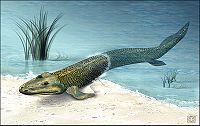Difference between revisions of "Tiktaalik"
Conservative (Talk | contribs) |
Conservative (Talk | contribs) |
||
| Line 42: | Line 42: | ||
|conservation=Extinct | |conservation=Extinct | ||
}} | }} | ||
| − | '''Tiktaalik roseae''' is an extinct lobe-finned fish from the Devonian period. It has been dubbed a "fishapod" by one of its discovers, Neil Shubin, and is claimed to be a [[transitional form]] between fish and [[Tetrapod|tetrapods]] (in this case, amphibians). It is dated by [[evollution|evolutionists]] at aproximately 375 million years, while young earth [[creation science|creation scientists]] hold the earth is approximately 6,000 years old. | + | '''Tiktaalik roseae''' is an extinct lobe-finned fish evolutionist claim it is from the Devonian period. It has been dubbed a "fishapod" by one of its discovers, Neil Shubin, and is claimed to be a [[transitional form]] between fish and [[Tetrapod|tetrapods]] (in this case, amphibians). It is dated by [[evollution|evolutionists]] at aproximately 375 million years, while young earth [[creation science|creation scientists]] hold the earth is approximately 6,000 years old. |
==As a transitional== | ==As a transitional== | ||
Revision as of 05:38, May 12, 2011
| Tiktaalik | |
|---|---|

| |
| Scientific classification | |
| Kingdom Information | |
| Domain | Eukaryota |
| Kingdom | Animalia |
| Subkingdom | Bilateria |
| Phylum Information | |
| Phylum | Chordata |
| Sub-phylum | Vertebrata |
| Infraphylum | Gnathostomata |
| Class Information | |
| Class | Osteichthyes |
| Sub-class | Sarcopterygii |
| Infra-class | Tetrapodomorpha |
| Genus Information | |
| Genus | Tiktaalik |
| Species Information | |
| Species | T. roseae |
| Population statistics | |
| Conservation status | Extinct |
Tiktaalik roseae is an extinct lobe-finned fish evolutionist claim it is from the Devonian period. It has been dubbed a "fishapod" by one of its discovers, Neil Shubin, and is claimed to be a transitional form between fish and tetrapods (in this case, amphibians). It is dated by evolutionists at aproximately 375 million years, while young earth creation scientists hold the earth is approximately 6,000 years old.
As a transitional
Tiktaalik was clearly aquatic and was clearly a fish. However, it has several features which resemble those of amphibians, considered the earliest tetrapods. Its front fins contain primitive wrist bones and even bones which resemble fingers, suggesting that Tiktaalik used its fins to bear weight, though most likely not to actually walk. Tiktaalik also had a neck, a distinctly tetrapod feature. It probably had primitive lungs in addition to gills. It also had its eyes on the top of its head, similar to the position of the eyes in amphibians such as salamanders.
As a fish
Despite its tetrapod-like features, creationists contend that it was simply a specialized fish. Though its fins somewhat resemble limbs, they were not connected to its vertebra, meaning two things: Tiktaalik itself certainly could not walk like a true tetrapod, and the fin bones would have to become fused to the vertebra in order for the evolution of tetrapods to be complete.
Also, several living species of fish exhibit the ability to "walk" or crawl over land using their fins,[1] though these fish are not considered significant in the fish-to-tetrapods issue.
Reconstruction of Tiktaalik
The above image is from the National Science Foundation, a U.S. Government agency to fund science. While reconstructions such as this one appear to show what the species in question really looked like, the true appearance of Tiktaalik is unknown. For example, the difference in appearance between the head and the "shoudler" area is speculative. So is the implication in the image that Tiktaalik walked on land. It is just as likely that it used its robust fins to "walk" on the sea floor, helping it to catch prey in an alligator-like manner. While the tail is included in the image, the tail and rear fins have not been found.